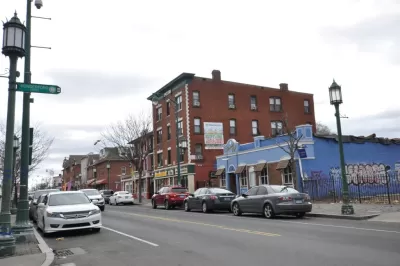The state of Connecticut deploys almost all of its federal housing funding in impoverished communities, according to this bombshell investigatory report.

Jacqueline Rabe Thomas reports from Connecticut as an example of how policy uses low-income housing tax credits to erect pockets of poverty.
"[Connecticut] officials have chosen, year after year, to direct the bulk of public funding for affordable housing to Connecticut’s most impoverished communities," writes Thomas. "Since the mid-1980s, almost $2.2 billion in low-income housing tax credits have been awarded to construct 27,000 affordable housing units in the state. Just 10% were built in prosperous towns, an investigation by The Connecticut Mirror and ProPublica has found."
Some 80 percent of that funding was spent in struggling communities in Connecticut, making it an outlier among a national average which tends toward spending low-income housing money in impoverished areas. "In a recent federal study [pdf] of 21 states, it had the second highest concentration of affordable housing in high-poverty neighborhoods, behind only Mississippi," according to Thomas.
The article traces the systematic origins of these outcomes in Connecticut (e.g., "The state requires developers to obtain local zoning approval before they even apply for a tax credit, a practice that has been flagged by federal regulators as potentially discriminatory) and also the consequences of the pattern for the residents living in subsidized housing in these low-income communities.

Alabama: Trump Terminates Settlements for Black Communities Harmed By Raw Sewage
Trump deemed the landmark civil rights agreement “illegal DEI and environmental justice policy.”

Planetizen Federal Action Tracker
A weekly monitor of how Trump’s orders and actions are impacting planners and planning in America.

The 120 Year Old Tiny Home Villages That Sheltered San Francisco’s Earthquake Refugees
More than a century ago, San Francisco mobilized to house thousands of residents displaced by the 1906 earthquake. Could their strategy offer a model for the present?

In Both Crashes and Crime, Public Transportation is Far Safer than Driving
Contrary to popular assumptions, public transportation has far lower crash and crime rates than automobile travel. For safer communities, improve and encourage transit travel.

Report: Zoning Reforms Should Complement Nashville’s Ambitious Transit Plan
Without reform, restrictive zoning codes will limit the impact of the city’s planned transit expansion and could exclude some of the residents who depend on transit the most.

Judge Orders Release of Frozen IRA, IIJA Funding
The decision is a victory for environmental groups who charged that freezing funds for critical infrastructure and disaster response programs caused “real and irreparable harm” to communities.
Urban Design for Planners 1: Software Tools
This six-course series explores essential urban design concepts using open source software and equips planners with the tools they need to participate fully in the urban design process.
Planning for Universal Design
Learn the tools for implementing Universal Design in planning regulations.
Clanton & Associates, Inc.
Jessamine County Fiscal Court
Institute for Housing and Urban Development Studies (IHS)
City of Grandview
Harvard GSD Executive Education
Toledo-Lucas County Plan Commissions
Salt Lake City
NYU Wagner Graduate School of Public Service




























